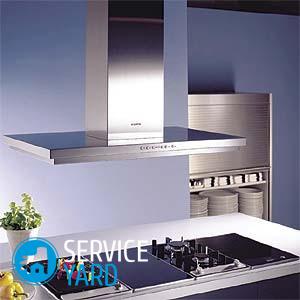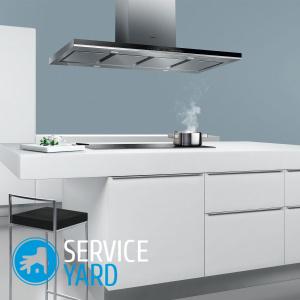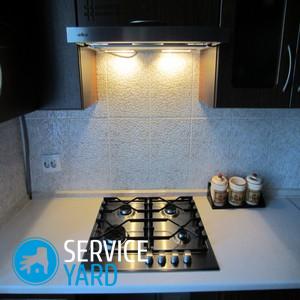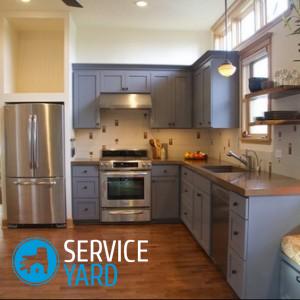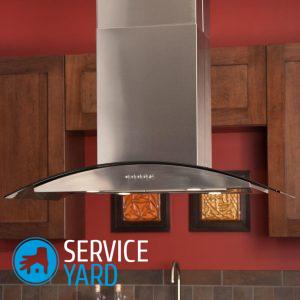How to choose a hood for the kitchen?
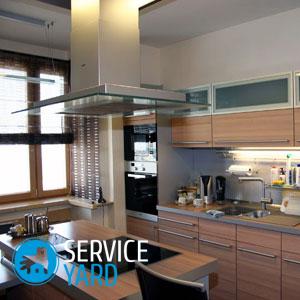
The kitchen is a very important part of the house. The owners of large apartments here cook, sometimes eat, sometimes make close friends. If the apartment is small, then in the kitchen there may be a small workshop, a TV, and much more. In a word, the owners spend a lot of time in this room, which means that the conditions here should be the most comfortable. And an important role in this is played by air quality. The smell of burnt fat, so usual where food is cooked, can pretty much spoil your mood, and your appetite too. The hood will help you out. We’ll talk about how to choose a hood for the kitchen.
to contents ↑Retraction or recycling?
To begin, think about what means you have. Choosing a hood for the kitchen will be much easier if you know in advance how much money you can allocate. According to the principle of operation, kitchen hoods are divided into three types:
- bypass, they are flowing;
- recirculation;
- mixed.
Exhaust hoods
As the name implies, exhaust hoods remove polluted air from the room. Such an extractor draws in air, passes through filters, and then throws it out through the kitchen ventilation or a hole in the wall.
Important! Filters are needed only to protect the inside of the hood, they are quite simple, and therefore exhaust hoods are cheaper than others. In a separate article you will find duct hood rating.
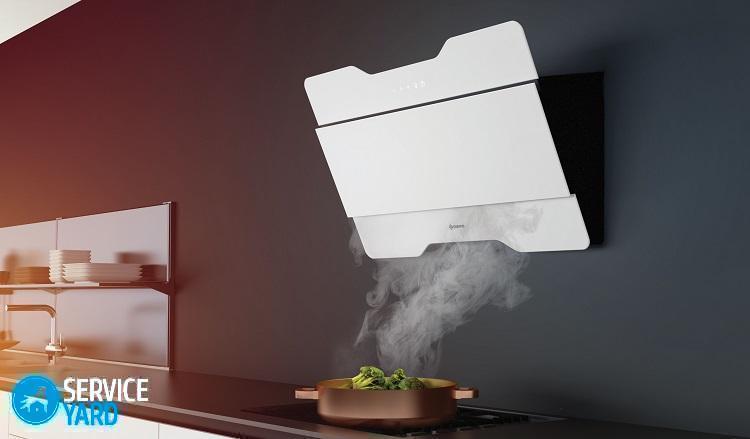
Recirculation hoods
These hoods also suck in air, but do not take it out, but clean it with a rather complicated filter system, and then return it to the room. No additional holes in the wall are required, but the mechanism itself is quite complicated. Therefore, recirculation hoods are more expensive than flow hoods. If the cost does not bother you, use the ready-made overview of the best models of hoods without duct.
Mixed hoods
These hoods can work both in flow mode and in recirculation mode. They cost about the same as high-quality recirculation ones.
to contents ↑Determine the power
On sale you can now find hoods designed for a wide variety of kitchens - from 16 to 50 m. How to choose a hood to ensure the required air quality and at the same time be quite economical? - First you need to calculate the required power. It depends on two factors:
- kitchen area;
- the height at which the hood is supposed to be installed.
Important! There are sanitary standards - the air in the kitchen should be updated on average 12 times per hour, that is, once every five minutes.
Calculate power as follows:
- Measure the length, width and height of the kitchen.
- Multiply what you got (just remember to translate everything into meters).
- Multiply the result by the norm of air exchange - in our case, by 12.
- Multiply what happened by 1.6 - this is the safety factor.
The result obtained means the required power.
Important! If you did not find a hood in the store or catalog, the parameters of which would correspond exactly to the result obtained, select a device with a higher power, so that there is a margin.
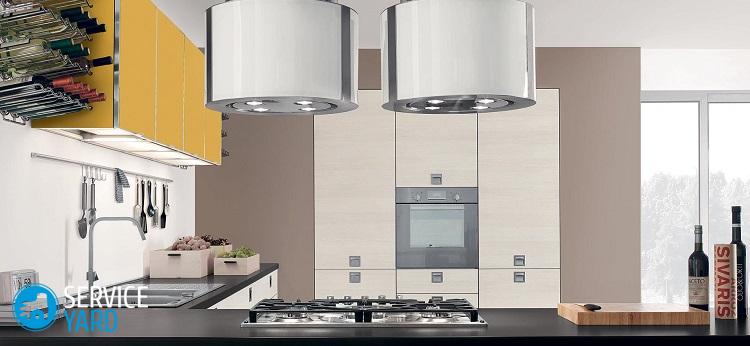
A bit about fans
The fan is the “heart” of the hood. There can be one or two of such “hearts”.Actually, when they talk about the power of the hood, the power of the fans is determined - how much air they can overtake in a certain time.
to contents ↑Important! The performance of modern fans, which are used in household models, is usually somewhere between 180 m2 / hour and 700 m3 / hour.
We deal with the dimensions
In stores you can find hoods of various sizes - from 60 to 90 cm. Which one to choose? - The criterion in this case is your stove. The hood should be no less than the cooking surface of the stove, and better - a little more.
to contents ↑Important! When installing such equipment, other parameters are taken into account, and not just the size of the working area. All these nuances directly affect further efficiency. Read about how it should be distance from the hood to the stove.
What else to look for?
There is a simple pattern - the larger the hood, the more it emits noise. True, reputable manufacturers have dealt with this problem - noise is reduced by adjusting the fan speed. But unfortunately, not all companies strive to make their products less noisy, so do not forget to ask the seller about this.
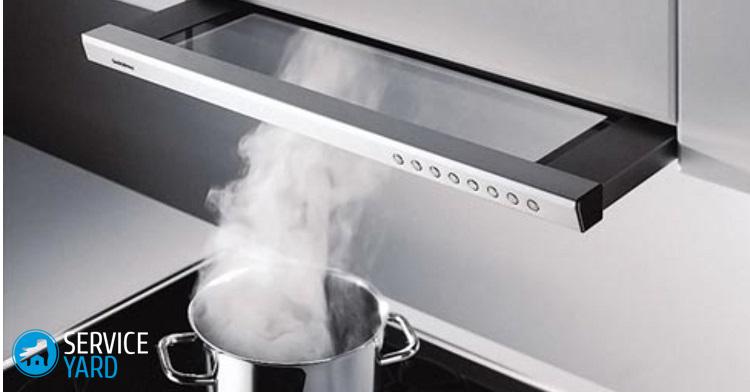
Types of hoods
Having decided on the power and principle of operation, inspect your kitchen. The problem of how to choose a hood for the kitchen is solved taking into account all circumstances, including the size of the kitchen and existing furniture. If you started a global reorganization and have not yet bought new furniture, everything becomes much simpler - first choose equipment, and only then tables and chairs. In all other cases, you will have to consider what is already in the kitchen. By the method of installing the hood there are:
- mounted;
- wall mounted;
- angular;
- island
- built-in;
- domed, they are mantelpieces;
- desktop.
Important! Before choosing a model of such equipment, be sure to think about the layout of the room. Take a few options from our review of furniture arrangement ideas.
Mounted
Faced with the question of how to choose the right hood for the kitchen, many owners prefer this particular type. Hinged hoods are relatively easy to mount over a stove to a wall or cabinet. As a rule, they operate on a recirculation principle. Of the hoods of this type, they are the cheapest, and in addition, they fit almost any kitchen design.
Wall mounted
Such hoods are also installed directly above the stove. They are a kind of canopy with a long pipe. Everyone who enters the kitchen will certainly see this hood, so in this case it is very important how it looks and how suitable it is for the interior.
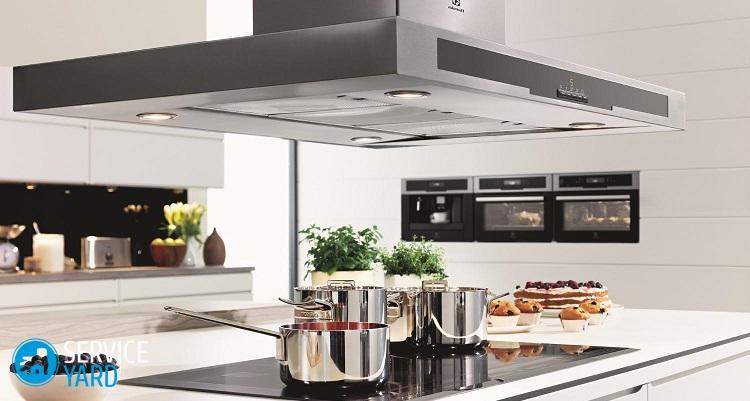
Corner
In essence, they are also wall mounted, only they are not attached to one wall, but to two. Manufacturers are simply showing miracles of fantasy - perhaps such models look most impressive, and in addition, their design is extremely diverse.
Island
Such a hood is convenient if you are going to place it not against the wall or above the stove in the corner, but in the middle. In large kitchens, this option is quite common. Island hoods work mainly in recirculation mode, but mixed-type island air purifiers can also be found on sale.
Embedded
Such a hood is convenient both in a large kitchen and in a small one. She hides in a closet, only a piece of filter is visible from the outside. However, there are transformer models, the size of which may vary depending on conditions. Such models have a sliding panel, which allows you to increase the filter area.
Dome
These are hoods for stylish kitchens. By design, they very much resemble fireplace chimneys. As a rule, they are quite expensive, but the design is exquisite, and they work flawlessly.
Tabletop
Their advantage is small dimensions, which makes such air purifiers simply indispensable in small kitchens and studio apartments.This is just an add-on module that attaches to the kitchen table.
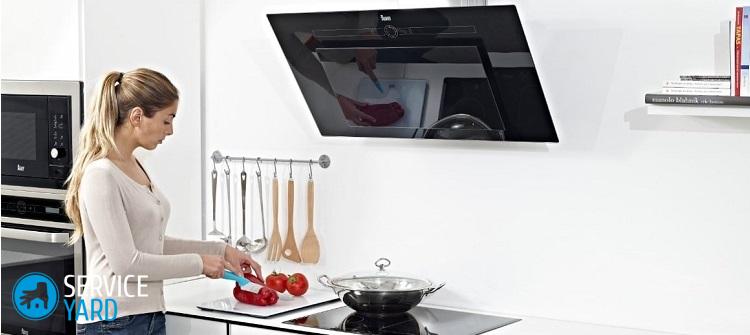
Which management do you prefer?
For many, this issue is secondary, but if you decide how to choose a cooker hood so that all family members can use it, pay attention to management methods. It can be:
- buttons and keys that are turned on mechanically;
- electronic keys;
- human-responsive electronic systems;
- Remote Control;
- sensors.
to contents ↑Important! The most affordable ones are mechanical hoods or those that can be turned on and off using the remote control. Electronic keys can be turned on with the touch of a finger even a small child. Touch models regulate an operating mode independently. And equipment with an electronic system is an indispensable thing for a “smart home”.
Which lighting to choose?
The lamps that are used to illuminate such devices are also very diverse. It can be:
- conventional incandescent bulbs;
- halogen;
- neon
- luminescent.
to contents ↑Important! Incandescent lamps are cheaper than others, but they do not last long, and they consume plenty of electricity. The most economical halogen lamps.
What to attach to?
An important point is the connection of the hood with the ventilation system of the house. This is usually done using a short pipe. The principle “the shorter the better” applies here, excess knees only harm the air vent, reducing performance by about 5%.
The best option is a wide air vent with smooth walls. Sometimes someone who wants to install the hood himself, argues from the point of view of ease of installation - and, of course, prefers corrugated pipes. But what is convenient during installation does not always work well. Corrugated pipe also reduces power.
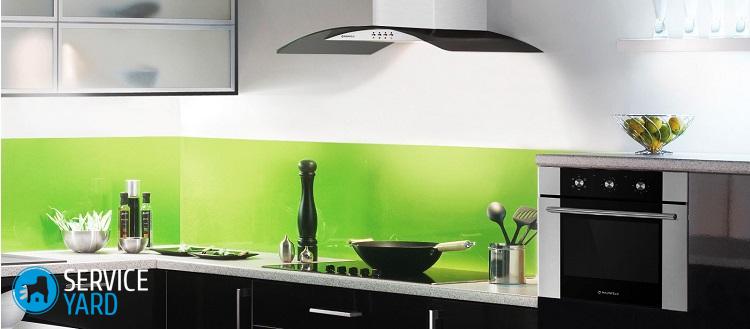
A little about the price
The cost of such equipment can be very different. It depends on many parameters:
- material;
- power;
- working principle;
- management methods
- design.
The following conclusion follows from this:
- The cheapest models are made of special plastic, in which metal is added, they have a small power and mechanical control method, and the design is without any frills.
- Models of the average price scale are made, as a rule, of stainless steel. They have average power, they can be controlled remotely. However, among hoods that are controlled by sensors or electronic keys, there are relatively inexpensive models.
- Finally, expensive models - durable materials, high power, stylish design, convenient controls - sensors or “smart home”.
to contents ↑Important! To fully own all the necessary information and understand the scope of the upcoming work, also read the detailed hood installation instructions.
Stock footage
Now you have a full understanding of how cooker hoods differ, what they are and how to choose a cooker hood for the kitchen. We hope that with the help of our tips you were able to choose the best option for your home, and now in the kitchen pleasant and clean air will always reign, and not the smell of burning.




